Pachypodium saundersii
Pachypodium saundersii N.E.Br.
Family: Apocynaceae
Common names: kudu lily, rathbonia (Eng.); koedoelelie (Afr.); isihlehle, insema-yamatshe (isiZulu); sikhubakhuba, ligubaguba (siSwati).
Introduction
A low succulent shrub with a large tuberous stem up to 1 m in diameter, mostly above ground and often irregularly shaped, few spiny branches and showy white flowers in autumn. It grows mostly among rocks in relatively dry woodland.

Description
Description
Pachypodium saundersii is a succulent shrub growing 0.5 to 1.5 m high, with a large, tuberous stem bearing 1 to several branches. The branches are erect, thick at the base tapering rapidly to 5-10 mm in diameter, with a thin, papery, pale grey bark and paired spines 20-70 mm long. The leaves are thinly textured, medium-green above, paler below, glossy, and can be 30-80 mm long and 10-40 mm wide.

The flowers are produced at the tips of the stems, mainly in autumn to early winter (February-May). The flowers are large, white flushed with pink to purple on the outside of the corolla, white above and greenish on the inside of the corolla tube. The fruit consists of 2 horn-like mericarps, 80-100 mm long and 10 mm wide, splitting to release numerous small seeds with a tuft of whitish hairs at one end.
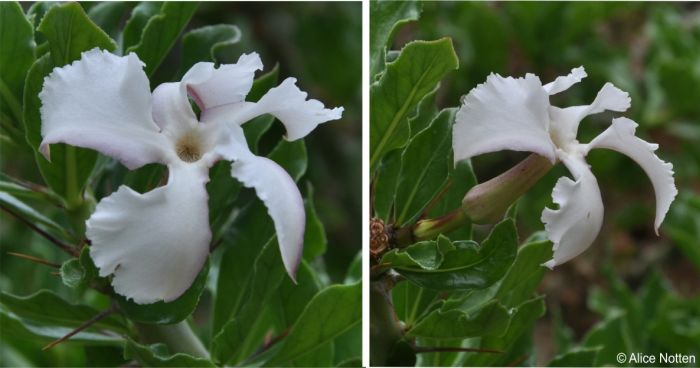
Conservation Status
Status
According to the Red List of South African Plants, although Pachypodium saundersii has lost 20% of its habitat and is at risk from invasive alien plants and harvesting, it is still widespread and abundant and is assessed as Least Concern (LC) but should be monitored.
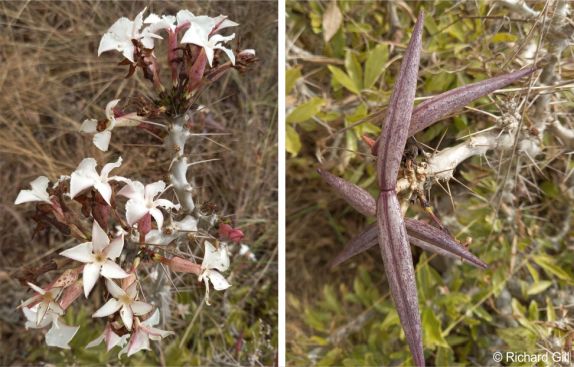
Distribution and habitat
Distribution description
Plants grow among rocks, often in rock crevices, in full sun, in relatively dry lowveld woodland, occurring in KwaZulu-Natal, Limpopo and Mpumalanga in South Africa, and in Eswatini, southern Zimbabwe and Mozambique.
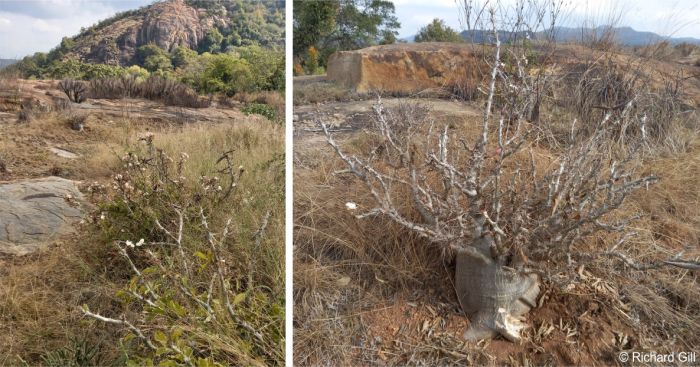
Derivation of name and historical aspects
History
The genus name Pachypodium is derived from the Greek words pachy, which means ‘thick’ and podus, which means ‘foot’, referring to the tuberous base. The species name saundersii is in honour of a magistrate and plant collector C.J.R. Saunders (1857-1935) who collected the type specimen in the Barberton District in 1891.
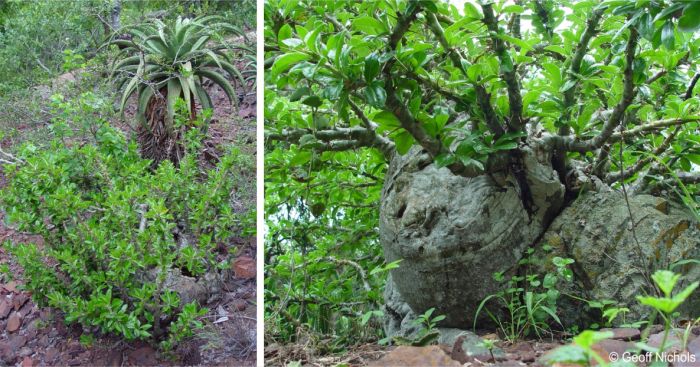
Ecology
Ecology
The thick succulent stem of Pachypodium saundersii stores water and enables the plant to survive in its hot, dry habitat and to survive long periods of drought. The pale bark also helps the stems keep cool by reflecting sunlight. The seeds are dispersed by wind, the tufts of hairs on the seeds allow the seeds to be lifted and carried away by gusts of wind.

Uses
Use
Like all species in the genus Pachypodium, Kudu Lily is highly poisonous and caution should be exercised when handling this succulent because of its poisonous properties, and spines. In ancient times these plants were most effectively used as an arrow poison when hunting. In Eswatini, Pachypodium saundersii is used to treat toothache.
Pachypodium saundersii makes a good accent plant in a rock garden or large container, especially when grouped together with other caudiciform succulent plants such as species of Adenia, Adenium, Pelargonium, Cissus and Cotyledon. All need full sun, lots of water (except during the dormant phase) and must have good drainage.
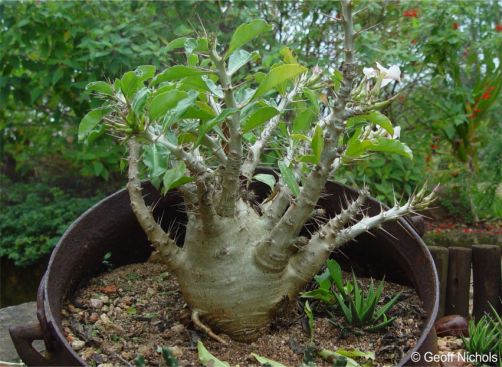
Growing Pachypodium saundersii
Grow
Pachypodium saundersii is best propagated from seeds. Harvest fresh seeds and propagate as soon as possible, so they do not lose their viability. Remove the parachute of silky hairs, sow the seeds about 5 mm deep in a light, sandy medium such as a mixture of 4 parts fine and 4 parts coarse river sand, 1 part sieved compost, 1 part perlite and 1 part vermiculite. Keep the medium moist and warm to ensure rapid germination of the seeds, they require a warm environment of 27-35°C. Seeds take up to 6 weeks to germinate, if there is no germination they are regarded as not viable.
Propagate vegetatively through tip cuttings taken in spring or summer, allow the cut ends to dry for a week or so to form a callus and treat the fresh cut with a fungicide or flowers of sulphur to prevent rotting. Treat the cut end with rooting hormone and plant the cuttings in the same medium as that used for sowing seeds. Place the cuttings in a warm, semi-shaded, well-ventilated environment until rooted.
Best for warm, frost-free gardens with a cool, dry winter. Plant in well-drained soil in full sun or semi-shade. Allow the plants to remain dry during the winter dormant period. Take care not to overwater.
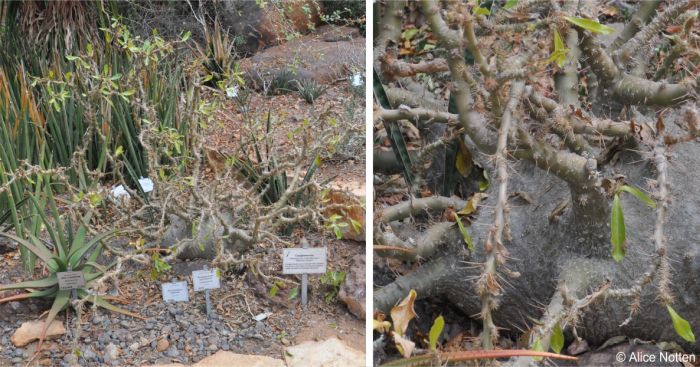
References
- Bester, S.P. 2007. Pachypodium Lindl. (Apocynaceae). PlantZAfrica. Online. http://pza.sanbi.org/pachypodium.
- Codd, L.E. 1963. Apocynaceae. In R.A. Dyer, L.E. Codd and H.B. Rycroft (eds). Flora of southern Africa 26:244-296. Botanica Research Institute, Pretoria.
- Gill, R. 2022. Observation of Pachypodium saundersii, Ehlanzeni, Mpumalanga. iNaturalist. Online. https://www.inaturalist.org/observations/125158208.
- JSTOR Global Plants. Holotype of Pachypodium saundersii N.E.Br. https://plants.jstor.org/stable/10.5555/al.ap.specimen.k000234113?searchUri=filter%3Dname%26so%3Dps_group_by_genus_species%2Basc%26Query%3Dpachypodium%2Bsaundersii.
- Leeuwenberg, A.J.M. & Kupicha, F.K. et al. 1985. Apocynaceae. In E. Launert, E.A. Bell & E.J. Mendes (eds). Flora Zambesiaca 7(2):395-503. Royal Botanic Gardens Kew, London.
- Loffler, L. & Loffler, P. 2005. Swaziland tree atlas including selected shrubs and climbers. Southern African Botanical Diversity Network Report No. 38. SABONET, Pretoria.
- Mhlongo, N.N. 2022. Pachypodium saundersii N.E.Br. National Assessment: Red List of South African Plants version. Accessed on 2024/05/17.
- Nichols, G. 2005. Growing rare plants: a practical handbook on propagating the threatened plants of southern Africa. Southern African Botanical Diversity Network Report No. 36.
- Smith, G.F., Crouch, N.R. & Figueiredo, E. 2017. Field guide to succulents in southern Africa. Struik Nature, Cape Town.
Credits
Khanyisile Nkosi
Pretoria National Botanical Garden
May 2024
Acknowledgements: additional images by Geoff Nichols, Richard Gill and Alice Notten, as credited.
Plant Attributes:
Plant Type: Shrub, Succulent
SA Distribution: KwaZulu-Natal, Limpopo, Mpumalanga
Soil type: Sandy, Loam
Flowering season: Late Summer, Autumn, Winter
PH: Acid, Neutral
Flower colour: Purple, White, Pink
Aspect: Full Sun, Morning Sun (Semi Shade), Afternoon Sun (Semi Shade)
Gardening skill: Average
Special Features:
Horticultural zones








Rate this article
Article well written and informative
Rate this plant
Is this an interesting plant?
Login to add your Comment
Back to topNot registered yet? Click here to register.